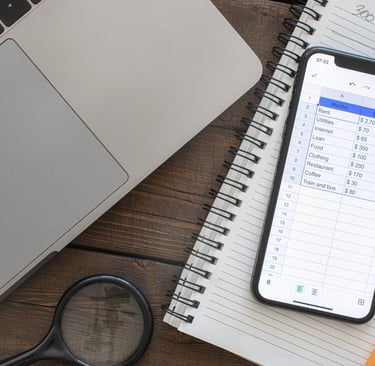Budgeting Basics: How to Create and Stick to a Budget
A budget can help you track expenses, save for the future, and reduce financial stress. Here are 5 essential tips to create and stick to a budget.
Finistack
1/15/20252 min read


Creating a budget is one of the most effective ways to take control of your finances, reduce stress, and achieve your financial goals. Whether you're saving for a big purchase, paying off debt, or building long-term wealth, a budget helps you track income and expenses. Here are five essential tips to create and stick to a budget successfully.
1. Track Your Income and Expenses
Before creating a budget, understand where your money is going. List all your income sources, such as salary, freelance work, or rental income. Then, track your expenses for a month, including fixed costs (rent, utilities) and variable costs (groceries, entertainment). With this information, you will have better control over managing your money. For example, if you earn $4,000 monthly and spend $500 on dining out, cutting back to $250 can free up extra savings.
2. Follow the 50/30/20 Rule
A simple budgeting method is the 50/30/20 rule:
50% for necessities (rent, utilities, groceries)
30% for wants (entertainment, dining out, shopping)
20% for savings and debt repayment
For example, if your monthly income is $3,000, aim to allocate $1,500 for needs, $900 for wants, and $600 for savings and debt repayment.
3. Set Clear Financial Goals
Having specific goals keeps you motivated to stick to your budget. Goals can be short-term (paying off credit card debt), medium-term (saving for a car), or long-term (retirement). Let's say you want to save $1,200 for a vacation in a year, then you can set aside $100 per month in a dedicated savings account. Better yet, you can automate the saving process by setting up a reoccurring payment if you have relatively consistent income every month. This way, you will stay diligent and discipline to achieve your financial goal.
4. Use Budgeting Tools and Apps
Managing your budget is easier with financial apps like YNAB (You Need a Budget), or EveryDollar. These tools track your spending, send alerts, and help you stay on course. If you tend to overspend on groceries, an app can notify you when you’re nearing your limit for the month.
5. Review and Adjust Regularly
A budget isn’t static—it should adapt to changes in your income and expenses. Review it monthly and make adjustments as needed. If you get a raise, increase your savings rather than expanding discretionary spending.
Final Thoughts
Creating and sticking to a budget is key to financial success. By tracking expenses, setting goals, using budgeting tools, and adjusting when necessary, you can take control of your finances and build a secure future.
**Disclaimer: This blog may include AI-generated content derived from web crawling, and it features quotes from original cited inline or public sources. The information presented is for general informational purposes only and may not reflect the most current data or information available. While we strive for accuracy, we encourage readers to verify the information from original sources or reach out to a certified financial adviser for important financial decisions.
